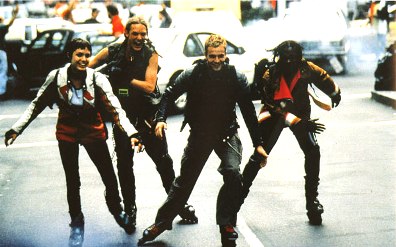Today’s world speeds ahead faster than anyone can keep track. No sooner does Facebook oust MySpace when Twitter swoops in to dethrone them both; paperbacks are threatened by the Kindle, and CD players are obsolete. In this swiftly changing culture, sometimes it’s nice to revisit a simpler era, when camouflage was edgy and passwords were lettersonly: the world of 1995’s Hackers.
One of the most rewarding guilty pleasure movies of all time, Hackers explores the life of a handful of cooler-than-thou tech savants who find themselves framed for a virus written by a snotty over-thirty systems admin. These hackers, who look like the bridge of the starship Enterprise after an run-in with Hot Topic, have to escape the Feds, unite the hackers of the world, and break into the mainframe of an oil company from some payphones in Grand Central.
Ah, cinema verité!
As a technology time capsule, the film’s a scream. The hackers crowd into a bedroom during a party to drool over a laptop with a 28.8 modem; the main MacGuffin is a 3.5″ floppy disk. (Imagine how an entire sequel could be framed around the desperate search to find a computer that can read a 3.5″ floppy in time to discover what’s on it before evil plan launches.)
However, the film functions beautifully as a snapshot of the computer culture of 1995, when most people were fumbling their way through Windows and tearing the edges off their dot matrix printers, but some people had discovered the potential of socially networked computers. In 1995, the Internet was still a brave new world that only the elite could grasp, an alien landscape of translucent skyscrapers through which the hacker could fly, searching for the file that would set him free from the clutches of The Man.
Aesthetically, the film is a checklist of Things Moviemakers Hope Young, Edgy People Liked in 1995:
– Rollerblades. (The first sign that corporate system admin Plague can’t be trusted is his arrival by skateboard, a tool of The Man.)
– TV stations that run off a single modem.
– Well-behaved rave parties.
– First-person, blurry, public video game consoles.
– Techno music. All the time.
– The Canadian mom from La Femme Nikita.
– Rollerblades.
– Jolt Cola.
– Pay phones.
– Mock turtlenecks.
– Matthew Lillard.
The film holds up remarkably well even against the many and egregious infractions against reality, largely because of the cast, which elevates the script from workmanlike to quotable. (Let the one who has never used “It’s in that place where I put that thing that time” cast the first stone.)
The archetypal plot, which pits a spunky band of outsiders against the powerful machine of the state, is nothing new; the hackers who join our heroes’ cause and overwhelm the Gibson mainframe at the film’s climax are PVC-armored Rohirrim, marshaling behind Johnny Lee Miller’s comely Frodo. On the other hand, if your archetypal trope ain’t broke, don’t fix it—and the idea of a company out to smother the spread of information is a theme that has become more, not less, timely in the last decade.
But it’s not the attack on freedom of information that has kept Hackers popular; the key to Hackers‘ enduring camp appeal is that, like all weirdlycostumed cinema manifestos about our future, Hackers is 90% deliciously inaccurate and 10% frighteningly prescient. When Acid Burn summons Cereal Killer and he gets the emergency message on his beeper, howl with laughter and record the sound as your iPhone ring. When the Secret Service hands Plague a police report and he groans, “Ugh, hard copy,” realize that someone looked into the future and saw us all.
Remember, citizens of 1995—on the Internet there are no text prompts; there are only imaginary buildings that you hack into with a four-character password.










